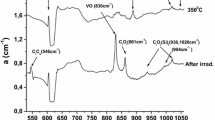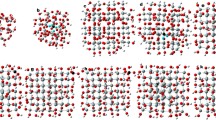Abstract
Carbon–oxygen-self-interstitial defects in silicon (Si) are technologically important as they can impact the operation of devices through the concentration of intrinsic point defects. In irradiated Si the CiOi defect attracts self-interstitials (SiI’s) and leads to the formation of the CiOi(SiI). Experimental studies have determined that annealing at 150 °C results in the capturing of more SiI’s leading to the formation of the CiOi(SiI)2 defect. Recent experimental studies proposed that the CiOi(SiI)2 defect is bistable and considered possible configurations. In the present study we aim to clarify the structure of the CiOi(SiI)2 defect and use density functional theory calculations to gain insights on the formation and stability of the CiOi(SiI)2 defect in Si. It is calculated that two configurations are energetically favourable differing in energy by only 0.19 eV.
Similar content being viewed by others
Avoid common mistakes on your manuscript.
1 Introduction
Throughout the evolution of microelectronics silicon (Si) was the dominant material, however, there is a recent technological requirement to replace Si with higher mobility substrates [1–10]. At any rate Si will continue to be technologically important as it is the mainstream material for photovolatics and sensors.
Point defects and defect clusters are important in devices as they can influence their properties. To optimise devices the control of oxygen-related defects such as the A-center (vacancy-oxygen interstitial pairs, VO) and the carbon-related defects (such as CiOi(SiI)n, n = 1, 2,…) is required [11–18].
Irradiation in Si leads to the association of O and C to form the CiOi defect (C3) [19, 20]. When considering high irradiation dose the CiOi may attract a SiI’s to form the CiOi(SiI) complex (C4) and thereafter even larger complexes such as the CiOi(SiI)2 [16, 20–23]. In a recent study Angeletos et al. [15] introduced a model concerning a transformation of the CiOi(SiI) complex to the formation of CiOi(SiI)n (2 ≤ n ≤ 4) complexes. In particular, Angeletos et al. [15] proposed that CiOi(SiI)2 exhibits a bistable behavior switching between two configurations depending on the temperature. In the present study we employ density functional theory calculations to investigate the structure of the CiOi(SiI)2 defect.
2 Methodology
2.1 Details of calculations
In the present study we employed the plane wave density functional theory code CASTEP [24, 25]. Exchange and correlation interactions were implemented within the corrected density functional of Perdew, Burke and Ernzerhof (PBE), [26] using the generalized gradient approximation (GGA) and with ultrasoft pseudopotentials [27]. The plane wave basis set cut-off was 350 eV, a 2 × 2 × 2 Monkhorst–Pack (MP) [28] k-point grid was used, in conjunction with a 250-atom supercell. The convergence and efficacy of this theoretical methodology has been discussed in previous studies [29, 30].
2.2 Definitions of binding energies
The criterion we set to compare the stability of the different configurations of the CiOi(SiI)n defect is the binding energy. For example, the binding energy to form a CiOi(SiI)2 defect in Si is given by:
where \(E({{\text{C}}_{\text{i}}}{{\text{O}}_{\text{i}}}{({\text{S}}{{\text{i}}_{\text{I}}})_2}S{i_N})\) is the energy of a N lattice site supercell (here N = 64) containing N Si atoms, a Ci, one Oi atom, two SiI and N Si atoms; \(E({C_i}S{i_N})\) is the energy of a supercell containing a Ci and N Si atoms; E(O i Si N ) is the energy of a supercell containing one Oi atom and N Si atoms; \(E({\text{S}}{{\text{i}}_{\text{I}}}S{i_N})\) is the energy of a supercell containing a SiI and N Si atoms; and E(Si N ) is the energy of the N Si atom supercell. With this definition a negative binding energy implies that the defect cluster is stable with respect to its constituent point defect components.
3 Results and discussion
In the present study we have employed extensive DFT calculations calculate the lowest energy structures of the CiOi(SiI)2 defect. We have used a step by step approach starting with the formation of the CiOi defect and then we have gradually added Si interstitials. In the process we have performed more than 4000 calculations exploring different geometries.
Consistently with previous DFT studies [14, 31, 32] the energetically favourable structure of the CiOi defect is the ring configuration (known as R-form) rather than the configuration where the Oi is occupying an interstitial site in between two Si (known as O-form) atoms that effectively resembles its position in undoped Si. The energy difference between these two configurations is 0.003 eV. In the ring configuration the C and O interstitials form with Si a ring, with the O–Si bond lengths being 1.79, 1.88, 1.75 Å, whereas the C–Si bond lengths being 1.77, 1.78 and 1.79 Å. The corresponding Si–O–Si and Si–C–Si angles are (139.9°, 131.5°, 88.6°) and (92.5°, 141.1°, 126.4°), respectively.
The second step in this process was to form the CiOi(SiI). This defect has been previously investigated by DFT [33] and hybrid functional DFT calculations [14]. Here we added the SiI not only to the energetically favourable R-form but also to the O-form. The extensive search was not confined to configurations with the SiI being close to the CiOi defect, however, it was calculated that these are prevalent in agreement with previous theoretical studies (Ref. [14] and references therein). The R-form CiOi(SiI) configuration is energetically fabourable as compared to the O-form CiOi(SiI) configuration by 0.18 eV. This is in agreement to the study of Backlund and Estreicher [33] where it was calculated that the difference between the two configurations is 0.27 eV. Comparing these two configurations it can be observed that the distinctive CiOi ring features have been rectified by the SiI. This is expected as in both configurations the local relaxation induced by the introduction of the third and more substantial interstitial is bound to lead to similar structures breaking the symmetry.
The third step of the process is to add a further SiI forming the O-form and R-form CiOi(SiI)2 configurations, Fig. 1a, and b respectively. In Fig. 1b the characteristics of the ring are now completely rectified. Therefore, one may consider these two configurations as being O-form. The configuration represented in Fig. 1b is energetically fabourable but by only 0.19 eV. Comparing to the recent phenomenological configurations proposed by Angeletos et al. [15] it can be observed that they have resemblances. This small energy difference will imply that there will be a non-negligible concentration of both CiOi(SiI)2 configurations.
In a simplified mass action analysis [34] approach where we consider that both CiOi(SiI)2 configurations effectively compete for the same Ci, Oi and SiI defects their relative concentration will be given by the temperature dependent factor exp(0.19 eV/kBT). This is an important factor as for example at 479 K there will be a hundred CiOi(SiI)2 with the Fig. 1b configuration for every CiOi(SiI)2 with the Fig. 1a. This ratio will become ten to one at 958 K and 3.55 to one near the melting temperature. Therefore, based on a simple mass action argument it is anticipated that both configuration will be present particularly at higher temperatures. This of course assumes that migration barriers will be similar and that competing structures will not readily form at higher temperatures. At any rate though it is demonstrated that the CiOi(SiI)2 cluster forms and that two configurations can acquire significant concentrations in good agreement with a recent experimental study [15].
4 Conclusions
Density functional theory calculations were used to calculate the relative stability and structure of the CiOi(SiI)2 defect. We propose that the formation of two O-form like CiOi(SiI)2 configurations with relative energies differing by only 0.19 eV. This is important as both will have comparable concentrations, particularly at higher temperatures. Here the systematic investigation focuses on the binding energies of the defects, however, kinetics may play a role on the formation of the CiOi(SiI)2 defect and this is presently under investigation. Finally, further computational studies are required to calculate competing carbon-related defects (such as CiOi(SiI)n and CiCs(SiI)n), the local vibration modes of the configurations proposed here and how these can be related with experiment.
References
C. Claeys, E. Simoen, Germanium-Based Technologies: From Materials to Devices (Elsevier, Amsterdam, 2007)
H. Wang, A. Chroneos, C.A. Londos, E.N. Sgourou, U. Schwingenschlögl, Appl. Phys. Lett. 103, 052101 (2013)
A. Chroneos, R.W. Grimes, B.P. Uberuaga, S. Brotzmann, H. Bracht, Appl. Phys. Lett. 91, 192106 (2007)
A. Chroneos, H. Bracht, Semicond. Sci. Technol. 25, 045002 (2010)
A. Chroneos, J. Appl. Phys. 105, 056101 (2009)
A. Chroneos, J. Appl. Phys. 107, 076102 (2010)
A. Chroneos, Semicond. Sci. Technol. 26, 095017 (2011)
A. Chroneos, Phys. Stat. Solidi B 244, 3206 (2007)
R. Kube, H. Bracht, A. Chroneos, M. Posselt, B. Schmidt, J. Appl. Phys. 106, 063534 (2009)
E. Bruno, S. Mirabella, G. Scapellato, G. Impellizzeri, A. Terrasi, F. Priolo, E. Napolitani, D. De Salvador, M. Mastramatteo, A. Carnera, Phys. Rev. B 80, 033204 (2009)
J. Coutinho, R. Jones, P.R. Briddon, S. Oberg, Phys. Rev. B 62, 10824 (2000)
C.A. Londos, A. Andrianakis, V.V. Emtsev, H. Ohyama, Semicond. Sci. Technol. 24, 075002 (2009)
A. Chroneos, C.A. Londos, E.N. Sgourou, P. Pochet, Appl. Phys. Lett. 99, 241901 (2011)
H. Wang, A. Chroneos, C.A. Londos, E.N. Sgourou, U. Schwingenschlögl, Sci. Rep. 4, 4909 (2014)
T. Angeletos, A. Chroneos, C.A. Londos, J. Appl. Phys. 119, 125704 (2016)
C.A. Londos, M. Potsidi, E. Stakakis, Physica B 340–342, 551 (2003)
A. Chroneos, E.N. Sgourou, C.A. Londos, U. Schwingenschlögl, Appl. Phys. Rev. 2, 021306 (2015)
E.N. Sgourou, D. Timerkaeva, C.A. Londos, D. Aliprantis, A. Chroneos, D. Caliste, P. Pochet, J. Appl. Phys. 113, 113506 (2013)
M.R. Brozel, R.C. Newman, D.H.J. Totterdell, J. Phys. C 8, 243 (1975)
G. Davies, C.R. Newman T.S. Moss, Handbook in Semiconductors, vol. 3b, ed. by S. Mahajan (Elsevier, Amsterdam, 1994), pp. 1557–1635
G. Davies, E.C. Lightowlers, R.C. Newman, A.S. Oates, Semicond. Sci. Technol. 2, 524 (1987)
L.I. Murin, J.L. Lindstrom, G. Davies, V.P. Markevich, Nucl. Instrum. Methods Phys. Res. B 253, 210 (2006).
L.I. Murin, B.G. Svensson, V.P. Markevich, A.R. Peaker, Solid State Phenomena, vol. 205–206 (Trans Tech, Zurich, 2014), p. 218
M.C. Payne, M.P. Teter, D.C. Allan, T.A. Arias, J.D. Joannopoulos, Rev. Mod. Phys. 64, 1045 (1992)
M.D. Segall, P.J.D. Lindan, M.J. Probert, C.J. Pickard, P.J. Hasnip, S.J. Clark, M.C. Payne, J. Phys. 14, 2717 (2002)
J. Perdew, K. Burke, M. Ernzerhof, Phys. Rev. Lett. 77, 3865 (1996)
D. Vanderbilt, Phys. Rev. B 41, 7892 (1990)
H.J. Monkhorst, J.D. Pack, Phys. Rev. B 13, 5188 (1976)
A. Chroneos, C.A. Londos, J. Appl. Phys. 107, 093518 (2010)
A. Chroneos, C.A. Londos, H. Bracht, Mater. Sci. Eng. B 176, 453 (2011)
R. Jones, S. Öberg, Phys. Rev. Lett. 68, 86 (1991)
J. Coutinho, R. Jones, P.R. Briddon, S. Öberg, L.L. Murin, V.P. Markevich, J.L. Lindström, Phys. Rev. B 65, 014109 (2001)
D.J. Backlund, S.K. Estreicher, Phys. Rev. B 77, 205205 (2008)
F.A. Kröger, V.J. Vink, Solid State Physics, vol. 3, ed. by F. Seitz, D. Turnbull (Academic, New York, 1956), p. 307
Author information
Authors and Affiliations
Corresponding author
Rights and permissions
Open Access This article is distributed under the terms of the Creative Commons Attribution 4.0 International License (http://creativecommons.org/licenses/by/4.0/), which permits unrestricted use, distribution, and reproduction in any medium, provided you give appropriate credit to the original author(s) and the source, provide a link to the Creative Commons license, and indicate if changes were made.
About this article
Cite this article
Christopoulos, SR.G., Sgourou, E.N., Angeletos, T. et al. The CiOi(SiI)2 defect in silicon: density functional theory calculations. J Mater Sci: Mater Electron 28, 10295–10297 (2017). https://doi.org/10.1007/s10854-017-6797-6
Received:
Accepted:
Published:
Issue Date:
DOI: https://doi.org/10.1007/s10854-017-6797-6





